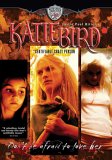Synopsis
After a very rough lovemaking session with her ethically dubious (to say the least) psychiatrist, KatieBird Wilkens (Helen Udy) knocks the sap down, chains him up, and proceeds to torture him, all the while recounting how she came to be a serial killer. Flashback to her childhood, and especially her adolescence, when her mild-mannered father (Lee Perkins) introduces her to the joys of killing. KatieBird (played in her teens by Taylor M. Dooley) develops her own unique way of dealing with her…victims: she wants them to hurt her, too.
Writer/director/producer/editor Justin Paul Ritter’s film is an assured piece of work. Though it runs a bit too long (with some scenes outstaying their welcome with repetitive dialogue), it is blessed by strong performances all around, but particularly in the case of the Dooley and Udy, who not only incinerate the screen with their intensity, they so convincingly played the same woman at different ages that I thought they WERE the same woman. The non-stop split-screen (single frame shots are few and far between) could easily have become irritating, but Ritter makes it work, emphasizing the fractured reality of his protagonist. Then there’s the gore. The full-on splatter is a while in coming, and the result is that one thinks the film is going to be more restrained than it is. Just when you expect the film to fade to black, it doesn’t. What then follows are torture sequences (teeth being yanked, faces sawn off) that go on for minutes at a time. This flick won’t be to everyone’s taste, but its ferocity is admirable.
Audio
The score (often rather reminiscent of King Crimson) is almost as non-stop as the split-screen, and does occasionally make the dialogue hard to make out. Said dialogue also sometimes distorts. But let’s keep the tiny budget in mind, shall we? At any rate, the surround is minimal, with even the score being largely confined to the front speakers. One notable exception is in the scene leading to the assault on KatieBird’s first victim. At this point, a very atmospheric rustling of leaves fills the space around the viewer.
Video
The budgetary limitations are present here, too, most notably in the case of aliasing that is quite prominent in the flashback scenes that take place in bright sunlight. The colours are okay, and often claustrophobically dark. The picture can, therefore, get a bit murky, but is almost always clear enough to get by. Grain is minimal, and there are no edge enhancement problems. The aspect ratio is nominally 1.85:1 anamorphic, but the image is so cut-up and juggled that this consideration hardly applies.
Special Features
Ritter is joined by cast-members Udy, Dooley and Perkins on the commentary, which, while containing the expected amounts of silly banter, is also plenty informative. The making-of featurette (“Movies NOT Excuses”) is a bit different, beginning as it does with a fully fledged rant from Ritter. “Misa Does Make-up” is another featurette whose title is self-explanatory. There are two Easter Eggs: go to the audio options menu and look for the hammer icons, and you’ll find two short interviews, one with Ritter, the other with the assistant director. The trailer, teaser and trailers for other Heretic releases are also included. The set is a bit more deluxe than most, however, as also included are liner notes from Ritter and the CD of the soundtrack. The menu is animated and scored, with rather long transitions. It’s also plenty loud.
Closing Thoughts
Heretic continues to release independent films that have high ambitious despite small budgets. This is one of their best releases so far.
Special Features List
- Audio Commentary
- Making-of Featurette
- Make-up Featurette
- Easter Eggs
- Trailers
- CD Soundtrack





